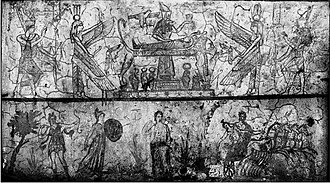The catacombs of Kom El Shoqafa (Arabic: مقابر كوم الشقافة; meaning “Mound of Shards”) is a historical archaeological site located in Alexandria,Egypt, and is considered one of the Seven wonders of the middle ages.
Catacombs
The catacombs were named Kom El Shoqafa, meaning Mound of Shards, because the area used to contain a mound of shards of terra cotta which mostly consisted of jars and objects made of clay. Those visiting the tombs left these objects, who would bring food and wine for their consumption during the visit. However, they did not wish to carry these containers home from this place of death, so they would break them. At the time of the discovery, people found heaps of these broken plates.
Layout

The catacombs lie beneath the western necropolis of Alexandria and consist of three levels cut through solid rock, the third level was completely underwater until recent restorations. The catacombs have a six-pillared central shaft which opens off the vestibule. On the left is a triclinum, a funeral banquet hall where friends and family gathered on stone couches covered with cushions, both at the time of burial and also on future commemorative visits.
Visitors can reach the first level through a breach in the rotunda wall, someone made it at an unknown date. This leads to the Hall of Caracalla in which the bones of horses and humans are there.
History
The necropolis consists of a series of Alexandrian tombs and statues of the Pharaonic funerary cult with Roman influences. Due to the time period, many of the features of the catacombs of Kom El Shoqafa merge Roman, Greek and Egyptian cultural points; some statues are Egyptian in style, yet bear Roman clothes and hair style whilst other features share a similar style. A circular staircase, which was often used to transport deceased bodies down the middle of it, leads down into the tombs that were tunneled into the bedrock during the age of the Antonine emperors (2nd century AD).
Principal tomb chamber

At the front of the tomb chamber there is a temple-like façade consisting of two columns topped by papyrus,lotus and acanthus leaves of ancient Egypt and supporting an architrave with a relief of a central winged sun-disk flanked by Horus falcons. A carved Agathodaemon in the form of a snake is flanking both sides of the entrance to the inner tomb. Each snake wears a Roman Caduceus and a Greek Thyrsus as well as the Egyptian Pschent . Figures of a man and a woman are into the wall. The man’s body has a stiff hieratic pose typical of Ancient Egyptian sculpture. The woman’s figure is also rigidly posed but bears the Roman hairstyle.
There are three huge stone sarcophagi with non-removable covers along the sides of the chamber. There is a hallway with 91 inch walls in the central tomb chamber providing burial space for mummies. The sarcophagi are with garlands and heads of Greek mythology gods. Each sarcophagus has associated a relief panel. The central panel shows the wolf-headed Anubis wearing Roman soldier garb, who mummifies a body lying on a lion bed. Below the bed are three canopic jars. The lateral panels show the Apis-bull receiving a gift.







Comment (0)